
The English Renaissance theatre or Elizabethan theatre was the theatre of England from 1558 to 1642. Its most prominent playwrights were William Shakespeare, Christopher Marlowe and Ben Jonson.

Raphael Holinshed was an English chronicler, who was most famous for his work on The Chronicles of England, Scotlande, and Irelande, commonly known as Holinshed's Chronicles. It was the "first complete printed history of England composed as a continuous narrative". The Holinshed Chronicles was a major influence on many Renaissance writers, such as Shakespeare, Spenser, Daniel and Marlowe.
William Harrison was an English clergyman, whose Description of England was produced as part of the publishing venture of a group of London stationers who produced Raphael Holinshed's Chronicles. His contribution to Holinshed's work drew heavily on the earlier work of John Leland.

The Merry Wives of Windsor or Sir John Falstaff and the Merry Wives of Windsor is a comedy by William Shakespeare first published in 1602, though believed to have been written in or before 1597. The Windsor of the play's title is a reference to the town of Windsor, also the location of Windsor Castle in Berkshire, England. Though nominally set in the reign of Henry IV or early in the reign of Henry V, the play makes no pretence to exist outside contemporary Elizabethan-era English middle-class life. It features the character Sir John Falstaff, the fat knight who had previously been featured in Henry IV, Part 1 and Part 2. It has been adapted for the opera at least ten times. The play is one of Shakespeare's lesser-regarded works among literary critics. Tradition has it that The Merry Wives of Windsor was written at the request of Queen Elizabeth I. After watching Henry IV, Part 1, she asked Shakespeare to write a play depicting Falstaff in love.
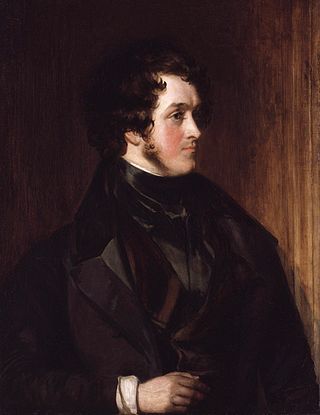
William Harrison Ainsworth was an English historical novelist born at King Street in Manchester. He trained as a lawyer, but the legal profession held no attraction for him. While completing his legal studies in London he met the publisher John Ebers, at that time manager of the King's Theatre, Haymarket. Ebers introduced Ainsworth to literary and dramatic circles, and to his daughter, who became Ainsworth's wife.
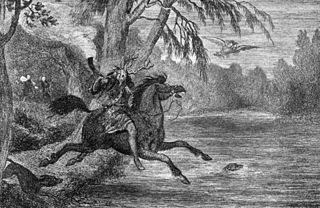
In English folklore, Herne the Hunter is a ghost associated with Windsor Forest and Great Park in the English county of Berkshire. He is said to have antlers growing from his head, rides a horse, torments cattle, and rattles chains. The earliest mention of Herne comes from William Shakespeare's 1597 play The Merry Wives of Windsor, and it is impossible to know how accurately or to what degree Shakespeare may have incorporated a real local legend into his work, though there have been several later attempts to connect Herne to historical figures, pagan deities, or ancient archetypes.

The term Cavalier was first used by Roundheads as a term of abuse for the wealthier royalist supporters of Charles I of England and his son Charles II during the English Civil War, the Interregnum, and the Restoration. It was later adopted by the Royalists themselves. Although it referred originally to political and social attitudes and behaviour, of which clothing was a very small part, it has subsequently become strongly identified with the fashionable clothing of the court at the time. Prince Rupert, commander of much of Charles I's cavalry, is often considered to be an archetypal Cavalier.
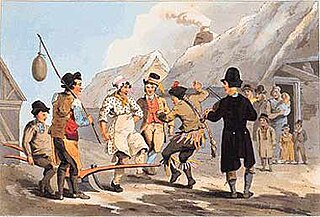
Plough Monday is the traditional start of the English agricultural year. Plough Monday is the first Monday after Epiphany, 6 January. References to Plough Monday date back to the late 15th century. The day before Plough Monday is referred to as Plough Sunday, in which a ploughshare is brought into the local Christian church with prayers for the blessing of human labour, tools, as well as the land.

The pollen basket or corbicula is part of the tibia on the hind legs of the female of certain species of bees. They use the structure in harvesting pollen and carrying it to the nest or hive where it is used as food by the colony.
The Brownists were a Christian group in 16th-century England. They were a group of English Dissenters or early Separatists from the Church of England. They were named after Robert Browne, who was born at Tolethorpe Hall in Rutland, England, in the 1550s. The terms Brownists or Separatists were used to describe them by outsiders; they were known as Saints among themselves.

William Shakespeare was an actor, playwright, poet, and theatre entrepreneur in London during the late Elizabethan and early Jacobean eras. He was baptised on 26 April 1564 in Stratford-upon-Avon in Warwickshire, England, in the Holy Trinity Church. At the age of 18, he married Anne Hathaway, with whom he had three children. He died in his home town of Stratford on 23 April 1616, aged 52.
Goodman was once a polite term of address, used where Mister (Mr.) would be used today. A man addressed by this title was, however, of a lesser social rank than a man addressed as Mister. Compare Goodwife.
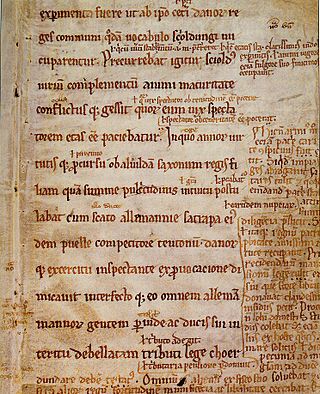
The sources of Hamlet, Prince of Denmark, a tragedy by William Shakespeare believed to have been written between 1599 and 1601, trace back as far as pre-13th century. The generic "hero-as-fool" story is so old and is expressed in the literature of so many cultures that scholars have hypothesized that it may be Indo-European in origin. A Scandinavian version of the story of Hamlet was put into writing around 1200 AD by Danish historian Saxo Grammaticus in his work Gesta Danorum. It is from this work that Shakespeare borrowed to create Hamlet. Similar accounts are found in the Icelandic Saga of Hrolf Kraki and the Roman legend of Lucius Junius Brutus, both of which feature heroes who pretend to be insane in order to get revenge. A reasonably accurate version of Saxo's story was translated into French in 1570 by François de Belleforest in his Histoires Tragiques. Belleforest embellished Saxo's text substantially, almost doubling its length, and introduced the hero's melancholy.

Holinshed's Chronicles, also known as Holinshed's Chronicles of England, Scotland, and Ireland, is a collaborative work published in several volumes and two editions, the first edition in 1577, and the second in 1587. It was a large, comprehensive description of British history published in three volumes.

Emery Molyneux was an English Elizabethan maker of globes, mathematical instruments and ordnance. His terrestrial and celestial globes, first published in 1592, were the first to be made in England and the first to be made by an Englishman.
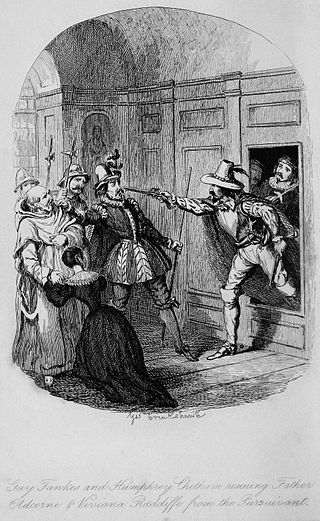
The novel Guy Fawkes first appeared as a serial in Bentley's Miscellany, between January and November 1840. It was subsequently published as a three-volume set in July 1841, with illustrations by George Cruikshank. The first of William Harrison Ainsworth's seven "Lancashire novels", the story is based on the Gunpowder Plot of 1605, an unsuccessful attempt to blow up the Houses of Parliament. Ainsworth relied heavily on historical documents describing the trial and execution of the conspirators, of whom Fawkes was one, but he also embellished the known facts. He invented the character of Viviana Radcliffe, daughter of the prominent Radcliffe family of Ordsall Hall – who becomes Fawkes's wife – and introduced gothic and supernatural elements into the story, such as the ability of the alchemist, John Dee, to raise the spirits of the dead.

Old St. Paul's, also titled Old Saint Paul's: A Tale of the Plague and the Fire, is a novel by William Harrison Ainsworth serially published in 1841. It is a historical romance that describes the events of the Great Plague of London and the Great Fire of London. It was the basis for the 1914 silent film Old St. Paul's.
Henrietta Maria Bowdler (1750–1830), commonly called Mrs. Harriet Bowdler, was an English religious author and literary expurgator, notably of the works of William Shakespeare.
The costard was a variety of apple popular in medieval England, and the second apple-variety introduced by the Normans. It was grown widely as a commercial crop by the 13th century and was supplied to the household of Edward I in 1292. It remained widespread for several hundred years, until other apple varieties gained popularity during the 17th century. It is thought to have been a cooking apple and was perhaps similar to the modern Bellflower apple. It is said to have been named for its resemblance to the human head.

The Shakespeare coat of arms is an English coat of arms. It was granted to John Shakespeare, a glover from Stratford-upon-Avon, Warwickshire, in 1596, and was used by his son, the playwright William Shakespeare, and other descendants.













